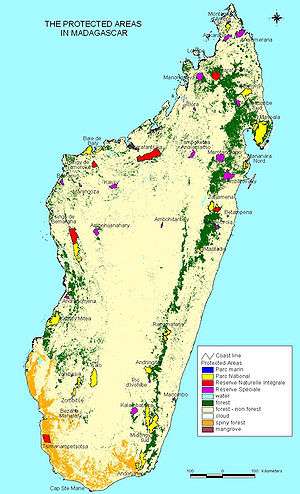Amber Mountain National Park
| Amber Mountain National Park | |
|---|---|
|
IUCN category II (national park) | |
 Location of Amber Mountain National Park | |
| Location | Northern Madagascar |
| Nearest city | Antsiranana |
| Coordinates | 12°30′08″S 49°09′58″E / 12.50222°S 49.16611°ECoordinates: 12°30′08″S 49°09′58″E / 12.50222°S 49.16611°E |
| Area | 182 km² |
| Established | 1958 |
| Governing body | Madagascar National Parks Association (PNM-ANGAP) |
Amber Mountain National Park is a national park in the Diana Region of northern Madagascar. The park is known for its endemic flora and fauna, water falls and crater lakes. It is 1,000 kilometres (620 mi) north of the capital, Antananarivo and is one of the most biologically diverse places in all of Madagascar with seventy-five species of birds, twenty-five species of mammals, and fifty-nine species of reptiles are known to inhabit the park.[1]

Geography
The park covers an area of 18,200 hectares (45,000 acres) on an isolated volcanic massif, of mostly basaltic rock, above the surrounding dry region.[1] Attractions include spectacular waterfalls and several crater lakes. There are numerous rivers and streams and the park is a water catchment area for the town of Antsiranana, which is surrounded by dry, sparse forests and semi-desert with succulent plants. Annual rainfall in the park is 3,585 millimetres (141.1 in) compared with 1,000 millimetres (39 in) around the town.[2]
Amber is one of the most accessible parks in northern Madagascar. Bush taxis travel to Joffreville daily from Antsiranana, taking about 45 minutes. On the trip up the mountain to the entrance of the park there are a few small villages and there is a lodge for guests at Joffreville.[2] Living in and around the park are the Sakavala and Antankarana peoples.[1]
Flora and fauna
Most of the park is covered montane rainforest with trees up to 40 metres (130 ft) tall and covered in lianas, orchids and ferns such as bird's-nest fern (Asplenium nidus). The forest is isolated from other rainforests by the surrounding dry region. There are plantations of Eucalyptus and exotic conifers, pines, Araucaria and an invasive alien bush, Lantana camara.[2] Over one thousand species of plants are recorded.[1]
Of the twenty-five species of mammals in the park, endemics include eight species of lemur, the ring-tailed mongoose (Galidia elegans) and the Malagasy civet (Fossa fossana). Thirty-five of the seventy-five species of birds are endemic including the Amber Mountain rock thrush (Monticola sharpei erythronotus) which is only known from one area on the Amber Mountain massif.[3] The park is also known for its amphibians and reptiles such as the Amber Mountain leaf chameleon (Brookesia ambreensis), which is one of the smallest reptiles in the world. There are thirty-five species of frog.[1]
See also
References
- 1 2 3 4 5 "Amber Mountain National Park". Madagascar Travel Guide. Retrieved 29 October 2016.
- 1 2 3 Preston-Mafham, Ken (1991). Madagascar: A Natural History. Oxford: Facts on File Limited. pp. 191–2. ISBN 0 8160 2403 0.
- ↑ "Monticola erythronotus". IUCN Red List Of Threatened Species. Retrieved 29 October 2016.
Sources
| Wikimedia Commons has media related to Amber Mountain National Park. |
